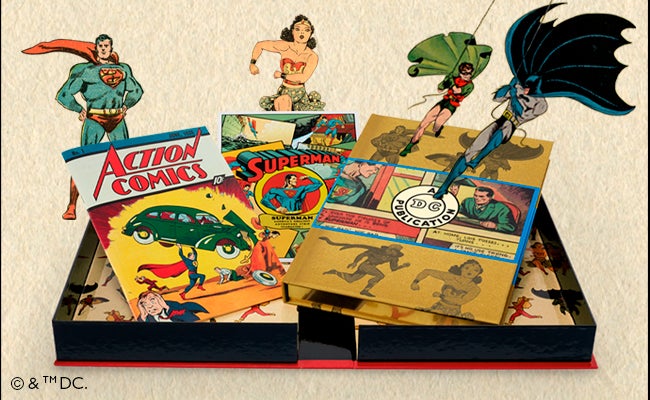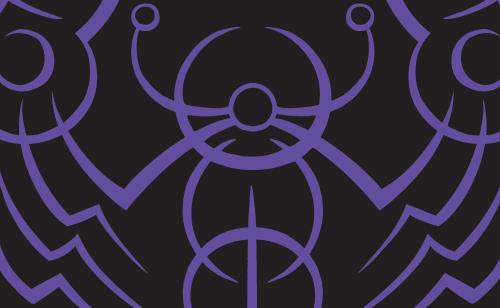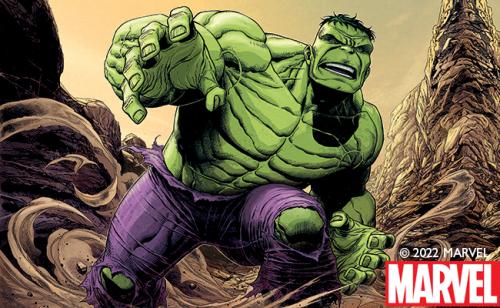Hero Status: An interview with Jenette Kahn
In this interview with Jenette Kahn, the former DC Editor-in-Chief discusses how she selected 18 stories for Folio’s DC Comics: The Golden Age, and offers rare insight into what made the stories of that time so powerful.
This article was first published in the Folio Autumn Magazine 2023.
DC Comics headquarters, 1985. Outside the office of a company supremo Jenette Kahn hangs a surprising image, a blown-up version of the 1939 Detective Comics #27 cover that first introduced Batman to the world.
Surprising? Perhaps not: Superman might be the jewel of the DC collection and the figure on which so many heroes were modelled, but Kahn has been a Batman nut since childhood. She was fascinated by his self-made powers and complex motivations, and she wanted everybody to know that she was a Batman kind of woman.
‘I always saw Batman as an artist,’ she says. ‘Somebody who was obsessive and completely dedicated to his craft. He was like somebody who practises an art, only his art was tracking down and catching criminals.
'So many of the other superheroes had powers you could never replicate or who came from other planets, but Batman made himself. To me that was a very compelling narrative. His whole world had a lot of depth. And, of course, he had the very best villains.'
Detective Comics #27 is just one of 18 classic DC comics that Kahn – one of the most significant and admired figures in the comic industry and a recipient of the Library of Congress's Living Legends award – has selected for Folio's DC Comics: The Golden Age (1938-1956), the first volume in a new partnership with DC.
The volume comes in a clamshell box with a print by DC artist Yanick Paquette, a replica issue of Action Comics #1 – the first Superman comic and one of the most valuable comics on the planet – and a hardback book reproducing comics that introduced Wonder Woman, the Flash, Green Lantern, Aquaman and the Joker to the world.
'I looked for the characters that are meaningful today,' says Kahn when explaining how she made the selection. 'I did slip Plastic Man in there as he is a personal favourite, but I wanted to feature the enduring characters and the stories that really established the template of these characters. These were the stories that would be re-examined by artists and writers in later years.'
Kahn's reign at DC was defined by the deepest of dives, as daring new writers such as Frank Miller, Grant Morrison and Alan Moore reimagined the characters created during DC's Golden Age. Already a fan, Kahn joined the company as publisher in 1976 when she was just 28 – the first woman and youngest person to head a division of Time Warner.
By then, she'd already founded three magazines for young people, attracting the attention of an organisation then still officially known as National Periodical Publications. Kahn changed it to DC in 1977. It would be just the first of several changes that would make DC a powerhouse on Kahn's watch.
'DC called me and said they were hiring their publisher and, as I was the expert in publishing for young people, would I talk to them?' she recalls. 'I didn't want a job and they said they weren't hiring but we had a very frank and animated conversation.
'Then I got a call from the chairman inviting me to lunch. I realised he might offer me a job that they had said didn't exist, so I had to decide whether I wanted to work for a company that published 80 comics a month and did merchandise, TV and movies. It was so completely over my head that I had to say yes.'
Kahn was quickly promoted to president and helped modernise DC by introducing new characters and complex, adult themes, and creating the genre that became known as 'graphic novels'. But even during these trailblazing days, those Golden Age comics remained the lodestone, the model for everything that followed.
Many of the writers and artists who created the gritty, morally challenging comics of the 80s and 90s had grown up immersed in the mythology of classic Superman, Batman and Wonder Woman. They were fans who knew this history backwards, and while they wanted to adapt their heroes for the modern reader, they did so with the greatest admiration for their antecedents.
'The comics and the characters were respected even if nobody wanted to replicate them in the 1980s,' she says. 'There was a desire to create more substantive stories, but not with any contempt for the Golden Age, because everybody understands there wouldn't be contemporary comics without these early ones.'
Looking back, she's now struck by the raw immediacy of these comics and delights in the sheer invention. A huge array of definitive characters – villains as well as heroes – were generated in a short period of immense creativity. These characters would occupy thrilling three-dimensional worlds packed with wit and imagination, drawn with skill and flair.
As she selected issues for the new Folio collaboration, Kahn was particularly impressed with the way the earliest plots crammed in so much information – never more so than the origin stories of the great superheroes, which later comics, books and films would re-examine time and again, but which originally passed by in a few short, rich, evocative panels.
'When you turn the pages, you feel they are speaking directly to you and you are fully involved in that world,' she says. 'There is a lack of cynicism, and you can feel and believe their objectives. You can be touched by – and share those objectives.
'These comics have the core, those things that are special to the character. The tradition is to expand and comment upon the character and find new depths and new explanations, but it always goes back to the core, and that is why these early comics are so essential. Later writers can take them in some very dark or unexpected directions but what makes the comic work is that core characterisation that you find in these early foundational comics.'
Kahn still marvels at the power of those early stories: 'In the early comics there is that concept that responsibility comes with power, and you can and should seek to make a difference,' she says. 'Wonder Woman brought explicit values that were quite forward-thinking for their time, and they gave something to cling on to – that there could be a better world.
'Gloria Steinem read her first Wonder Woman comic when she was seven, and has said she was fascinated by this woman who was stopping crime with one hand and feeding the hungry with the other. She was beautiful and strong and a sister to every woman. The idea that a superhero can inspire an entire life of such contribution and worth is embedded in these characters.'
During Kahn's era at DC, she was part of the team that brought Batman to the big screen in the 1989 film starring Michael Keaton as Batman and Jack Nicholson as the Joker. Here the mythology of Batman, first explored in Detective Comics #27, was dazzlingly reinterpreted, something that would happen with increasing frequency as Hollywood fell in love with the superhero. As Kahn writes in her introduction to the new Folio collection: 'The DC characters live in our hearts because of the continuous expansion of the foundational stories.'
Kahn is fascinated to see how comic-book characters have taken over the world: 'It's so interesting, the idea that 80 years from their first introduction you can tell stories with the same characters and still find new things to say and ask new questions. That is one of many things about these comics and characters that I find quite remarkable.'
Secure your copy of DC Comics: The Golden Age here.







